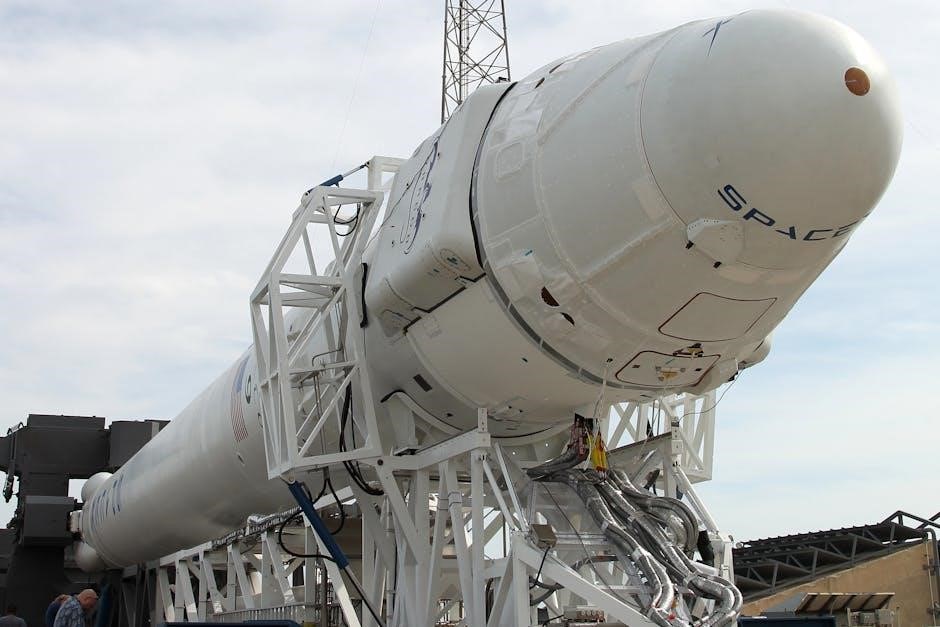The MD-83 experienced critical failures in its horizontal stabilizer trim system due to insufficient lubrication, leading to jackscrew assembly wear and eventual system failure, causing a fatal crash.
1.1 Background of the MD-83 Horizontal Stabilizer Trim System
The MD-83 horizontal stabilizer trim system is a critical component designed to maintain aircraft pitch attitude during flight. It adjusts the stabilizer’s angle to compensate for changes in weight, airspeed, and thrust, ensuring stable flight dynamics. The system incorporates a jackscrew assembly and Acme nut threads, which are essential for precise control. Lubrication plays a vital role in maintaining the system’s functionality by reducing friction and preventing wear. However, insufficient lubrication has been identified as a significant issue, leading to excessive wear and eventual failure of the jackscrew assembly. This system’s proper operation is crucial for safe flight, as its failure can result in loss of pitch control.
1.2 Importance of Lubrication in Aircraft Systems
Lubrication is essential for maintaining the functionality and longevity of aircraft systems, particularly in critical components like the MD-83’s horizontal stabilizer trim system. It reduces friction between moving parts, preventing excessive wear and overheating. Proper lubrication ensures smooth operation of mechanical components, such as the jackscrew assembly and Acme nut threads, which are vital for controlling pitch attitude. Inadequate lubrication can lead to premature wear, component failure, and potentially catastrophic consequences. Regular and sufficient lubrication is a cornerstone of aircraft maintenance, directly impacting safety and operational reliability. Its importance cannot be overstated, as evidenced by incidents where lubrication failures have led to system malfunctions and accidents.
1.3 Overview of the Incident Involving Lubrication Failure
The MD-83 incident involved Alaska Airlines Flight 261, which crashed into the Pacific Ocean due to a failure in the horizontal stabilizer trim system. Insufficient lubrication caused excessive wear on the jackscrew assembly, leading to the failure of Acme nut threads. This malfunction resulted in the horizontal stabilizer jamming, creating an uncontrollable nose-down pitch. The crew’s inability to correct the issue led to a fatal crash. The National Transportation Safety Board (NTSB) investigation identified inadequate lubrication as the primary cause, highlighting critical maintenance lapses and design vulnerabilities. This incident underscored the importance of proper lubrication practices in ensuring flight safety and system reliability.

MD-83 Horizontal Stabilizer Trim System Overview
The MD-83 horizontal stabilizer trim system adjusts pitch attitude during flight, compensating for weight, airspeed, and thrust changes using a jackscrew assembly and Acme nut threads.
2.1 Components of the Horizontal Stabilizer Trim System
The MD-83 horizontal stabilizer trim system consists of a jackscrew assembly, Acme nut threads, and a control system. The jackscrew assembly is central, converting electrical signals into mechanical movement to adjust the stabilizer’s angle. The Acme nut threads engage with the jackscrew, enabling precise pitch control. The system also includes sensors, actuators, and a control unit to monitor and adjust the stabilizer’s position. Proper lubrication of these components is critical to prevent wear and ensure smooth operation; The system’s design ensures stable flight dynamics by compensating for changes in weight, airspeed, and thrust.
2.2 Function of the Jackscrew Assembly
The jackscrew assembly is a critical component of the MD-83 horizontal stabilizer trim system, responsible for converting electrical signals into mechanical movement. It adjusts the stabilizer’s angle to maintain pitch control during flight. The assembly includes a screw and nut mechanism that moves the stabilizer, ensuring smooth and precise adjustments. Proper lubrication is essential to prevent wear and corrosion, which can lead to system failure. The jackscrew assembly’s functionality is vital for maintaining stable flight dynamics, compensating for changes in weight, airspeed, and thrust. Its failure can result in loss of pitch control, as seen in the MD-83 incident.
2.3 Role of Lubrication in the Trim System
Lubrication is essential for the smooth operation of the MD-83 horizontal stabilizer trim system. It prevents wear and corrosion on moving parts, such as the jackscrew assembly and Acme nut threads, ensuring precise and reliable adjustments. Proper lubrication reduces friction, allowing the system to function efficiently under varying flight conditions. Insufficient lubrication can lead to excessive wear, as seen in the MD-83 incident, where it caused jackscrew assembly failure and subsequent loss of pitch control. The NTSB highlighted that inadequate lubrication intervals contributed to this failure, emphasizing the critical need for regular maintenance to prevent such catastrophic events and ensure flight safety.
2.4 Consequences of Insufficient Lubrication
Insufficient lubrication in the MD-83 horizontal stabilizer trim system leads to severe consequences, including excessive wear on the jackscrew assembly and failure of Acme nut threads. This wear causes the system to malfunction, resulting in the inability to control pitch during flight. The jackscrew assembly failure can cause the horizontal stabilizer to jam, leading to an uncontrollable nose-down attitude. In the case of Alaska Airlines Flight 261, this scenario resulted in a fatal crash. The NTSB investigation revealed that extended lubrication intervals and inadequate maintenance practices exacerbated the issue, highlighting the critical importance of proper lubrication to prevent such catastrophic failures and ensure passenger safety.
Causes of Lubrication Issues in the MD-83
Design flaws in the jackscrew assembly, coupled with inadequate maintenance practices and extended lubrication intervals, were primary causes. FAA-approved extended intervals exacerbated the issue.
3.1 Design Flaws in the Jackscrew Assembly
The MD-83’s jackscrew assembly had inherent design flaws, including inadequate lubrication pathways and insufficient thread engagement. These issues made the system prone to wear and failure, even with proper maintenance. The Acme nut threads were particularly vulnerable, as they relied heavily on consistent lubrication to prevent excessive wear. Over time, these design limitations led to accelerated degradation, especially when combined with extended lubrication intervals. The flaws in the jackscrew assembly’s design were a critical factor in the lubrication-related failures experienced by the MD-83, ultimately contributing to the loss of pitch control during flight.
3.2 Inadequate Maintenance Practices
Inadequate maintenance practices significantly contributed to the MD-83 lubrication issues. Extended lubrication intervals, approved by the FAA, led to missed opportunities for proper servicing. Maintenance crews often overlooked critical lubrication points during routine inspections, exacerbating wear on the jackscrew assembly. Additionally, the lack of thorough end-play checks allowed excessive wear to go undetected. These oversights, combined with insufficient training on lubrication procedures, created an environment where critical maintenance tasks were not prioritized. As a result, the jackscrew assembly and Acme nut threads deteriorated faster than expected, ultimately leading to system failure and the tragic loss of the aircraft.
3.3 Extended Lubrication Intervals and Their Impact
Extended lubrication intervals for the MD-83’s horizontal stabilizer trim system played a pivotal role in the failure. The FAA-approved longer intervals reduced the frequency of necessary maintenance checks, leading to overlooked lubrication needs. This resulted in excessive wear on the jackscrew assembly and Acme nut threads. Over time, the lack of consistent lubrication caused metal-on-metal friction, accelerating component degradation. The extended intervals, while intended to reduce maintenance burdens, ultimately increased the risk of system failure. This oversight directly contributed to the catastrophic failure of the trim system, highlighting the importance of adhering to rigorous maintenance schedules to ensure flight safety and system reliability.
3.4 Contribution of FAA-Approved Extended Intervals

The FAA’s approval of extended lubrication intervals significantly contributed to the MD-83 incident. By allowing longer periods between maintenance checks, critical lubrication tasks were often overlooked. This reduction in oversight led to inadequate servicing of the jackscrew assembly and Acme nut threads. The extended intervals increased the likelihood of missed inspections, exacerbating wear and tear. Consequently, the lack of timely lubrication caused excessive friction, accelerating component failure. The FAA’s decision, aimed at reducing operational costs, inadvertently compromised safety standards. This oversight underscored the importance of balancing cost-efficiency with rigorous maintenance practices to prevent catastrophic failures in critical aircraft systems like the horizontal stabilizer trim system.

Effects of Lubrication Failure on the MD-83
Insufficient lubrication caused excessive wear on the jackscrew assembly, leading to Acme nut thread failure, stabilizer jamming, and loss of pitch control, resulting in the fatal crash.
4.1 Excessive Wear on the Jackscrew Assembly
The jackscrew assembly in the MD-83’s horizontal stabilizer trim system experienced excessive wear due to insufficient lubrication. This wear compromised the integrity of the Acme nut threads, leading to their eventual failure. The lack of proper lubrication caused metal-on-metal contact, accelerating wear and creating a scenario where the system could no longer function reliably. As a result, the stabilizer became jammed, leading to a loss of pitch control. This critical failure was a direct consequence of inadequate maintenance practices and extended lubrication intervals, which were not adequately addressing the system’s needs; Regulatory responses later emphasized the importance of regular lubrication checks to prevent such failures.
4.2 Failure of Acme Nut Threads
The failure of Acme nut threads in the MD-83’s horizontal stabilizer trim system was a direct result of insufficient lubrication and excessive wear. The threads, essential for the jackscrew assembly’s operation, stripped due to metal-on-metal friction, leading to a complete system failure. This failure caused the stabilizer to jam, resulting in an uncontrollable nose-down pitch. The NTSB investigation highlighted that the lack of adequate lubrication maintenance was the primary cause of this critical failure. The incident underscored the importance of adhering to strict lubrication schedules and conducting regular inspections to prevent such catastrophic failures in the future.
4.3 Jamming of the Horizontal Stabilizer
The MD-83’s horizontal stabilizer jammed due to the failure of the jackscrew assembly, caused by insufficient lubrication and excessive wear. This jamming locked the stabilizer in an extreme position, making pitch control impossible. The aircraft entered an unrecoverable nose-down attitude, leading to a fatal crash. The NTSB investigation revealed that the jamming was a direct consequence of the Acme nut threads failing, which prevented the stabilizer from moving correctly. This critical failure highlighted the importance of proper lubrication and regular maintenance to ensure the stabilizer’s freedom of movement and safe flight operations.
4.4 Loss of Pitch Control and Aircraft Crash
The MD-83 crash occurred due to a complete loss of pitch control caused by the failure of the horizontal stabilizer trim system. Insufficient lubrication led to the jackscrew assembly’s Acme nut threads failing, jamming the stabilizer in an extreme position. This caused the aircraft to enter an unrecoverable nose-down attitude. Despite crew efforts, the plane crashed into the Pacific Ocean, resulting in fatalities. The NTSB concluded that the primary cause was the loss of pitch control from the failed trim system, emphasizing the critical need for proper lubrication and maintenance to prevent such catastrophic failures in the MD-83 horizontal stabilizer trim system.
NTSB Investigation and Findings
The NTSB determined that insufficient lubrication caused the jackscrew assembly failure, leading to the MD-83 crash. The investigation highlighted critical safety issues and maintenance lapses.
5.1 Probable Cause of the Accident
The NTSB concluded that the probable cause of the MD-83 accident was the loss of pitch control due to the in-flight failure of the horizontal stabilizer trim system. This failure was attributed to the degradation of the jackscrew assembly’s Acme nut threads, caused by insufficient lubrication. The lack of adequate lubrication led to excessive wear, which ultimately resulted in the system’s mechanical failure. As a consequence, the horizontal stabilizer jammed in an extreme position, rendering pitch control impossible and leading to an unrecoverable nose-down attitude. This highlights the critical importance of proper lubrication and maintenance in ensuring flight safety;
5.2 Key Safety Issues Identified

The NTSB identified several key safety issues following the MD-83 accident. Insufficient lubrication of the jackscrew assembly was a primary concern, as it led to excessive wear and eventual failure. Additionally, the extended lubrication intervals approved by the FAA were found to increase the risk of missed or inadequate maintenance. The design of the horizontal stabilizer trim system, particularly the jackscrew assembly and Acme nut threads, was also scrutinized for its susceptibility to wear under insufficient lubrication. These factors collectively highlighted systemic gaps in maintenance practices and regulatory oversight, underscoring the need for enhanced safety measures to prevent future incidents.
5.3 Recommendations for Preventing Future Incidents
The NTSB recommended several measures to prevent future incidents. These included revising the lubrication intervals for the jackscrew assembly to ensure more frequent maintenance. Enhanced inspection protocols were suggested to detect early signs of wear and tear. Additionally, the FAA was advised to review and update its approval process for extended maintenance intervals. The implementation of more robust oversight of airline maintenance practices was also recommended. Furthermore, manufacturers were encouraged to improve the design of critical components like the Acme nut threads to reduce wear under normal operating conditions. These recommendations aimed to address both the technical and procedural gaps identified in the investigation.

Maintenance Practices and Solutions
Enhanced lubrication procedures, regular inspections, and adherence to manufacturer guidelines are critical to preventing future incidents and ensuring the reliability of the MD-83 trim system.
6.1 Enhanced Lubrication Procedures
Implementing enhanced lubrication procedures is vital for preventing wear in the MD-83’s horizontal stabilizer trim system. Regular application of high-quality lubricants ensures smooth operation of the jackscrew assembly and acme nut threads. Maintenance crews should follow detailed schedules, reducing intervals to prevent missed applications. Training programs emphasize proper techniques to avoid over-lubrication, which can attract debris. These measures address the root causes of past failures, ensuring system reliability and safety. By prioritizing lubrication, airlines can mitigate risks associated with excessive wear and potential system jamming, ultimately safeguarding flight operations and passenger safety.

6.2 Regular Inspection of the Jackscrew Assembly
Regular inspection of the jackscrew assembly is critical to ensuring the integrity of the MD-83’s horizontal stabilizer trim system. Inspectors must check for signs of wear, misalignment, or lubrication issues that could lead to system failure. Detailed visual examinations and measurements should be conducted during routine maintenance to identify potential problems early. Any anomalies, such as excessive wear on acme nut threads, must be addressed promptly. Neglecting these inspections can result in catastrophic failures, as seen in past incidents. By incorporating rigorous inspection protocols, airlines can prevent unexpected system malfunctions and ensure the safety of flight operations.
6.3 Overhaul Procedures for Critical Components
Overhauling critical components of the MD-83’s horizontal stabilizer trim system is essential for maintaining safety and performance. The jackscrew assembly and acme nut threads require thorough disassembly, cleaning, and inspection during overhaul. Any worn or damaged parts must be replaced with OEM-approved components to ensure reliability. Lubrication points should be meticulously serviced, and all moving parts should be tested for proper function. Following manufacturer guidelines is crucial to prevent future failures. Regular overhauls not only extend the lifespan of components but also minimize the risk of in-flight malfunctions, ensuring the aircraft remains airworthy and safe for operation.
6.4 Importance of Adhering to Manufacturer Guidelines
Adhering to manufacturer guidelines is paramount for ensuring the safety and reliability of the MD-83’s horizontal stabilizer trim system. Deviating from recommended procedures can lead to insufficient lubrication, accelerated wear, and potential system failure. Manufacturer guidelines provide detailed instructions for lubrication intervals, inspection protocols, and overhaul processes, all of which are critical for maintaining component integrity. By following these guidelines, maintenance teams can identify and address issues before they escalate, preventing catastrophic failures. Compliance also ensures regulatory adherence, reducing legal and operational risks. Ultimately, strict adherence to manufacturer guidelines is essential for safeguarding aircraft performance and passenger safety.

Regulatory Responses and Updates
Regulatory responses included FAA revisions to lubrication intervals, mandatory inspections, and updates to maintenance manuals. The NTSB’s findings led to industry-wide safety measures to prevent future incidents.
7.1 FAA Revisions to Lubrication Intervals
Following the MD-83 incident, the FAA revised lubrication intervals for critical components like the jackscrew assembly. These changes aimed to prevent excessive wear and failure. The FAA mandated stricter maintenance schedules, reducing the time between required lubrications. Additionally, the agency emphasized adherence to manufacturer guidelines to ensure proper system function. These revisions were part of a broader effort to address safety concerns identified by the NTSB. The updated intervals were designed to mitigate risks associated with insufficient lubrication, ensuring the horizontal stabilizer trim system operated reliably. This regulatory action marked a significant step in enhancing aviation safety and preventing future accidents.
7.2 Mandatory Inspections and Maintenance Checks
The FAA introduced mandatory inspections and maintenance checks for the MD-83’s horizontal stabilizer trim system. These measures included rigorous end-play checks and lubrication verification. Airlines were required to inspect the jackscrew assembly and Acme nut threads regularly. The frequency of these checks was increased to ensure early detection of wear or lubrication issues. Maintenance personnel were also trained to identify potential problems during routine overhauls. These mandatory inspections were critical in preventing future failures and ensuring compliance with safety standards. The enhanced checks provided an additional layer of safety, reducing the risk of system failure during flight.
7.3 Updates to Aircraft Maintenance Manuals

Following the MD-83 incident, the FAA mandated updates to aircraft maintenance manuals to address lubrication issues. Manuals now include detailed procedures for lubricating the jackscrew assembly and Acme nut threads. Enhanced inspection schedules ensure early detection of wear. Maintenance crews are required to follow strict guidelines for lubrication intervals and end-play checks. The updates emphasize proper documentation and compliance with safety standards. These revisions aim to prevent future failures by ensuring thorough maintenance practices. The updated manuals also provide clear criteria for replacing worn components, reducing the risk of system failure during flight. These changes are critical for maintaining aircraft safety and reliability.
7.4 Industry-Wide Implementation of Safety Measures
The MD-83 incident prompted industry-wide safety measures to prevent similar failures. The FAA mandated stricter lubrication and inspection protocols for all aircraft with similar systems. Airlines adopted enhanced maintenance practices, including more frequent lubrication checks and end-play inspections. The incident also led to the development of standardized training programs for maintenance crews, focusing on proper lubrication techniques and system monitoring. Regulatory bodies worldwide collaborated to ensure consistent safety standards, reducing the risk of lubrication-related failures. These measures have significantly improved aircraft safety, ensuring that critical systems like the horizontal stabilizer trim system receive the attention they require to prevent catastrophic failures.
The MD-83 incident underscores the importance of proper lubrication and maintenance, highlighting the need for continuous improvement in aircraft safety to prevent future tragedies and ensure passenger safety;
8.1 Lessons Learned from the MD-83 Incident

The MD-83 incident revealed critical lessons regarding lubrication practices in aircraft systems. Insufficient lubrication led to excessive wear on the jackscrew assembly, causing the horizontal stabilizer to jam and resulting in a fatal crash. This tragedy emphasized the importance of adhering to manufacturer guidelines and conducting regular inspections. Extended lubrication intervals, approved by the FAA, contributed to the failure, highlighting the need for rigorous maintenance protocols. The incident also underscored the importance of addressing design flaws and ensuring that safety measures are implemented industry-wide to prevent similar accidents in the future. These lessons remain vital for enhancing aviation safety globally.
8.2 Continuous Improvement in Aircraft Maintenance
The MD-83 incident underscored the necessity of continuous improvement in aircraft maintenance practices. Regular inspections of critical components, such as the jackscrew assembly, are now prioritized to detect early signs of wear. Enhanced lubrication procedures and adherence to manufacturer guidelines have become standard to prevent similar failures. Additionally, training programs for maintenance personnel have been refined to emphasize the importance of proper lubrication and inspection techniques. Regulatory updates, including mandatory inspections and revised maintenance intervals, ensure that such tragedies are avoided. These improvements reflect a commitment to safety and highlight the importance of proactive measures in modern aviation maintenance.
8.3 Importance of Lubrication in Modern Aviation
Lubrication plays a pivotal role in ensuring the reliability and safety of aircraft systems. The MD-83 incident highlighted how insufficient lubrication can lead to catastrophic failures, emphasizing its critical importance. Proper lubrication prevents excessive wear, corrosion, and overheating of components, ensuring smooth operation of critical systems like the horizontal stabilizer trim. In modern aviation, adhering to lubrication standards is non-negotiable, as it directly impacts flight safety and system longevity. The industry has learned that neglecting lubrication can result in devastating consequences, making it a cornerstone of maintenance practices. Continuous advancements in lubrication technologies further underscore its essential role in maintaining aircraft airworthiness and passenger safety.
